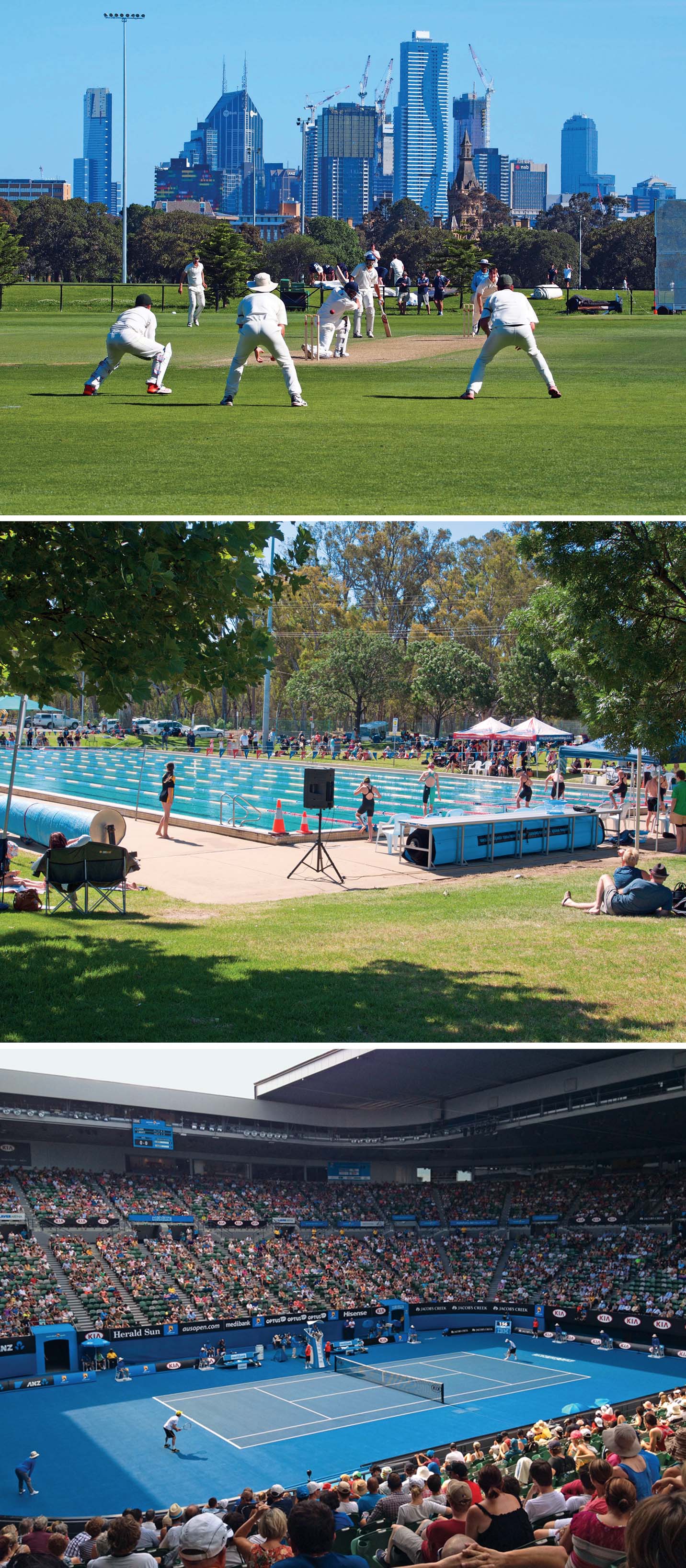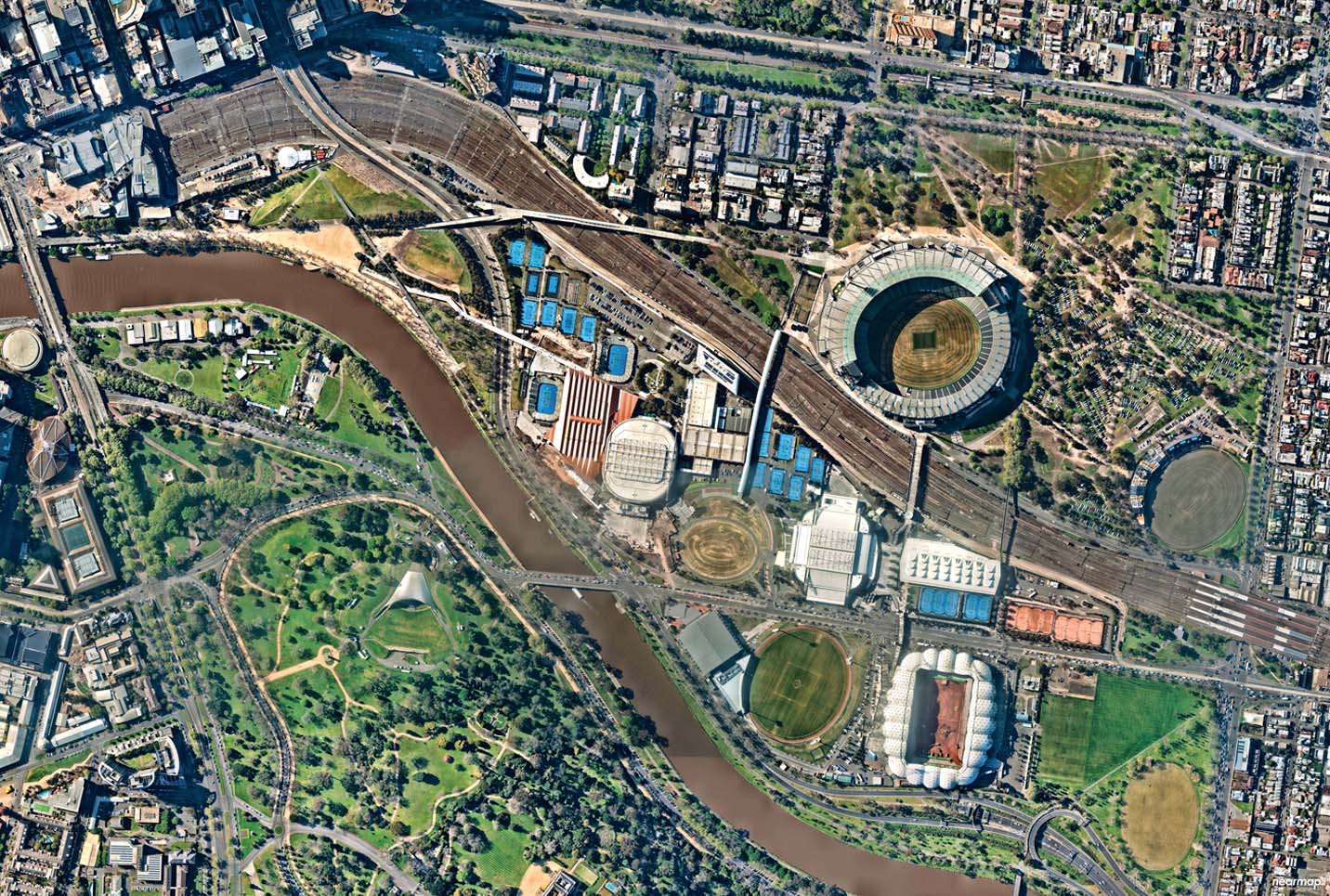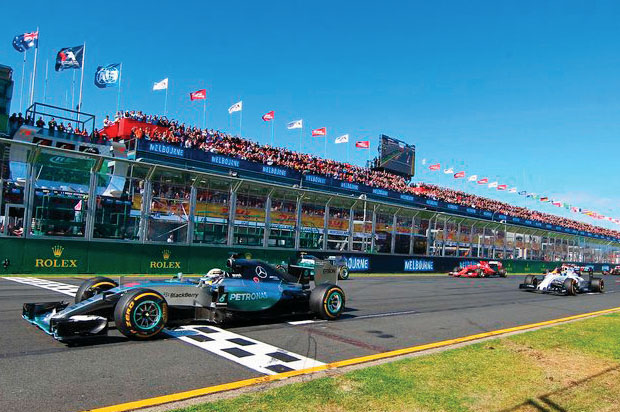Australia has long enjoyed a reputation as a successful sporting nation, with the stereotype of all Australians being sports-mad and unrefined. There are certainly elements of truth in this, though perhaps the reality is that more Australians like to talk about or watch sport rather than participate, and that leisure time is just as often used for visiting museums and theatres. Nevertheless, Australia does boast a range of facilities from the grand stadia to dusty country cricket pitches.
In the past, sporting clubs provided a focus for community activities in rural towns and then in the developing suburbs of the post-World War II period. Life was relatively simple 50 years ago; space was provided for football and cricket fields, a swimming pool and tennis and netball courts. These facilities together with the beach or a local river and the suburban backyard provided well for the community and family.
The role of sport in Australian cities and rural areas is changing as our big cities grow and become more dense and multicultural and high car ownership and advances in electronic entertainment open a vast range of opportunities for other activities. The influence of the digital age, together with a growth of less organised recreational activities like skating, surfing, skiing, fishing, hiking, cycling and other activities for youth, has seen a relative decline in once dominant team sports.
Longer working hours and a new appetite for cultural activities like galleries, theatre, music and cinema are also displacing traditional team sports. Watching sports has become big business, so Australians have, to some degree, become a nation of overweight voyeurs.

Middle: Public swimming pools have replaced less safe swimming in rivers and lakes throughout
Australian suburbs and towns over the past half century. Most Australian children learn to swim at an early age. This is important for their safety in a country with so many beaches and rivers as well as private pools. School swimming competitions throughout the country have fed our very successful national swimming teams since the 1950s
Bottom: Rod Laver Arena at Melbourne Park is the centre court and home to the finals
Australian cities have always taken major sporting facilities seriously. For example, Melbourne hosts the following events each year:
The Australian Tennis Open at Melbourne Park
This is held each year during the last fortnight in January and is the first of the four Grand Slam tournaments. Attendance is second only to the US Open and usually exceeds over 700,000 over the tournament. This event is televised worldwide. Melbourne Park is also used year-round as an entertainment venue for concerts and other events within three arenas with retractable roofs each accommodating between 15,000 and 7,500 patrons. It sits in parkland beside the MCG (Melbourne Cricket Ground) close to the heart of the CBD (Central Business District) making it a very attractive event for international and interstate visitors. Summer in Melbourne brings crowds of tennis fans from the northern hemisphere creating a carnival atmosphere in the city.
The Australian Formula One Grand Prix
Held at Albert Park within earshot of Melbourne’s CBD each March, it also attracts many international and interstate visitors and worldwide media coverage. Race day attendance usually exceeds 300,000.
Watching sports has become big business, so Australians have, to some degree, become a nation of overweight voyeurs
Australian Rules Football
This is a national winter competition with televised games around the country on three days or nights of the week. It is easily the most popular type of sporting event in terms of attendance for both men and women. And TV coverage over the season generates significant revenue within the country in a similar way to baseball or gridiron in the USA.
Melbourne has its Docklands Stadium with a retractable roof and a capacity of 60,000 people and the Melbourne Cricket Ground, that fills to its capacity of 100,000 for the Grand Final game in September.
Soccer and Rugby games are regularly televised events year-round at AAMI Park, a stunning new stadium with a capacity for 30,000 spectators.
The Spring Racing Carnival
It happens with four events over two weeks at Flemington Race Course with a total attendance of between 300,000 to more than 400,000.
The Melbourne Cup
This prestigious annual thoroughbred horse race is held on the first Tuesday in November and is a public holiday in Melbourne.

Middle: Australian golfer Matt Jones winning the 2015 Australian Open
Bottom: Spring Racing Carnival
Australian Open Golf Tournament
This tournament was first held in 1905 and is the oldest and most prestigious golf tournament on the PGA tour of Australasia. Golf courses around the country compete to host this event and while prize money is modest compared to the PGA and the European Tour, it still attracts big name golfers and large crowds and TV coverage.
Golf is a popular participant sport in Australia with excellent public and club facilities in rural and urban areas especially in the most populated states of Victoria and New South Wales. Unlike most other countries around the world, there is a range of golf courses easily accessible for most people who wish to play. This situation may not be sustainable in the future as cities become more intense and water becomes more precious.
Cricket
The Melbourne Cricket Ground (MCG) ends the year with the traditional Boxing Day Test when 70,000 or more fans arrive for the biggest test cricket attendance of the year no matter which opponent Australia is playing.
Melbourne’s sporting precinct
Most of these facilities are in the parkland within easy walking distance of the centre of the city where they are well supported by public transport. Melbourne hosted a very successful Commonwealth Games in 2006 by using the MCG as the main stadium, a role it also performed for the 1956 Olympic Games.

Sydney
Sydney now has equivalent sporting infrastructure that was developed for the 2000 Olympic Summer Games on a contaminated brown fields site at Homebush in Sydney’s western suburbs. Expenditure on developing new facilities for these games came at a very high cost that was not returned in the short term through economic benefit, but it did give a great stimulus to Sydney’s deprived western suburbs in terms of facilities, open space and transport infrastructure that has been followed up with more development and which is set to continue.
Sydney Olympic Park Master Plan 2030 released in 2010, suggests that by 2030, the urban precinct will ‘fulfil its destiny to become one of the world’s great contemporary civic spaces.’
Australian cities have always taken major sporting facilities seriously
Sport and Australian Cities in the Future
Australia is a sporting nation because most children are introduced to a range of sports at a young age and those that enjoy sport can participate in a wide range of team sports or any of the other forms of active leisure available in our cities and natural areas. A relatively benign climate allows most outdoor sports to be enjoyed year round. Those that have the interest, commitment and ability have the chance to progress to the professional level. This is possibly why our country seems to punch above its weight in so many sports at the international level.
On the other hand, our low-density suburbs and towns with their car-based lifestyle and ageing population means that the sporting image is hardly justified with a significant proportion of the population being overweight or obese because of sedentary lifestyles. Too much time is spent on the couch watching sport or at a computer when we may be healthier if we were participating more in physical activity as part of our daily routine.
An urban design challenge in Australian cities over the coming decades is to maintain access to a wide range of sporting activities for everyone, while at the same time designing our housing and cities to better encourage activity as part of our everyday life.
Increased density in our cities creates the opportunity to discourage car-based transport in favour of public transport, which in turn encourages walking and cycling regularly. Walking for exercise, gym and fitness classes, cycling and running are already the most popular sporting and physical activities for Australian men and women and they need to be further encouraged through city design for the health and well-being of the population.
All Photos: Bruce Echberg



Comments (0)